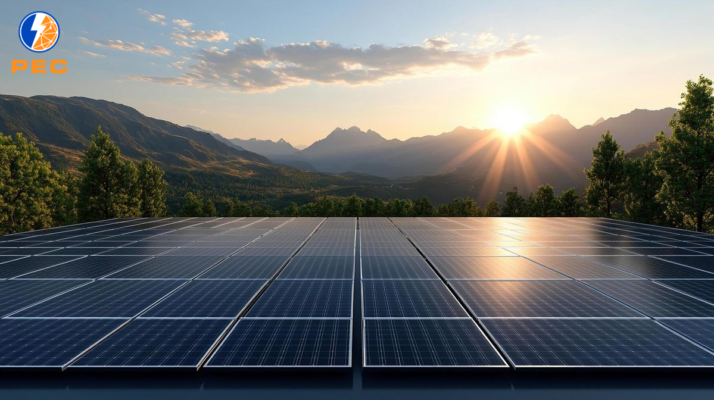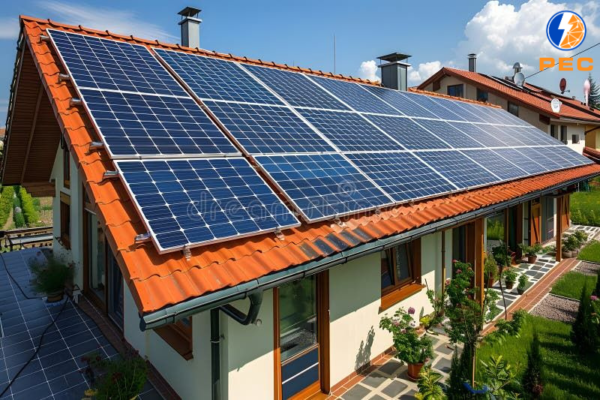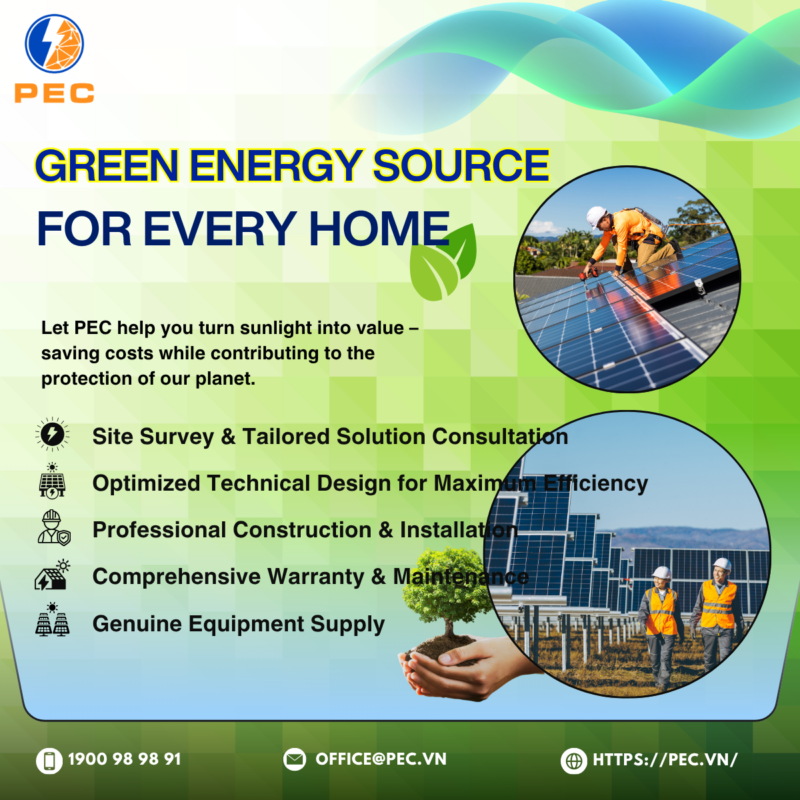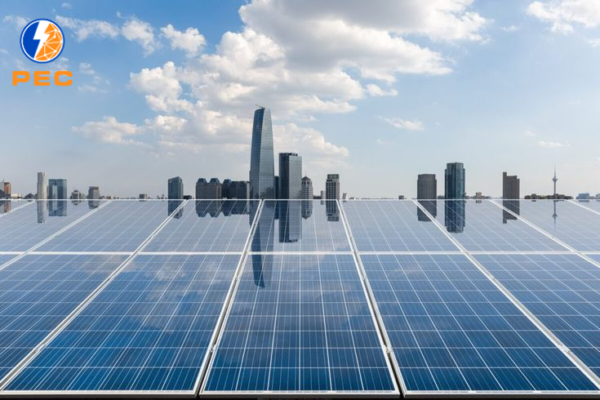1. Green Energy – The Inevitable Trend of Our Time
As climate change becomes increasingly severe and electricity prices continue to rise, the search for a stable, cost-effective, and environmentally friendly energy source has become an urgent necessity.

Solar power – the solution that converts sunlight into electricity – is now the top choice for thousands of households and businesses across Vietnam.
Not only does it help reduce monthly electricity expenses, but solar energy also contributes to lowering CO₂ emissions, protecting the environment, and moving toward the nation’s sustainable development goals.
2. Benefits of a Solar Power System for Households
2.1 Saving Electricity Costs — How It Works and Real Numbers

Saving Mechanism: A solar power system generates electricity right on your rooftop, prioritizing consumption for household appliances (self-consumption). When the generated power exceeds demand, the surplus can be fed into the grid or stored (if batteries are installed). This directly reduces the amount of electricity purchased from the grid — meaning lower monthly bills.
Estimated Example: For a household with an average demand of 8–12 kWh/day, a 3–5 kWp system typically covers most daytime consumption. Depending on the electricity rate and self-consumption level, actual savings can reach 40–80% of the electricity bill.
Influencing Factors: The level of savings depends on (1) system capacity relative to consumption, (2) self-consumption rate, (3) efficiency of solar panels/inverter, (4) roof orientation and tilt angle, and (5) grid connection mode/electricity buy–sell policy.
Payback Period: On average, a residential system achieves return on investment within 4–8 years (depending on initial investment, savings level, and government incentives). After this period, electricity is nearly free except for maintenance costs.
2.2 Energy Independence — Reducing Outage Risks and Increasing Self-Reliance
Less Dependence on the Grid: With solar power, households are less affected by grid issues (short-term outages) during the day. When combined with battery storage, the system can continue supplying power at night or during grid failures.
Flexible Operation: The system can be configured to prioritize self-consumption, battery charging, or grid feed-in — depending on your savings goals and desired level of energy independence.
Stable Power for Sensitive Devices: With proper system design and inverter selection, the output power remains stable and safe for electronic devices and small household equipment.
2.3 Safety and Environmental Friendliness — Standards and Long-Term Benefits
Technical Safety: Systems installed by reputable contractors following proper standards (connection, grounding, lightning protection, emergency shutdown) minimize risks of fire and technical faults. Choosing genuine equipment and adhering to installation standards enhance overall safety.
Environmental Protection: Every kWh of solar electricity generated replaces fossil fuel-based power, reducing CO₂ emissions and other harmful gases. Over time, the system helps significantly cut greenhouse gas emissions.
Community Benefits: When more households adopt solar energy, it eases pressure on the national grid during peak hours, contributing to a more stable electricity supply for the entire society.

2.4 Increasing Property Value — Financial and Aesthetic Benefits
Higher Sale/Rental Value: Properties equipped with renewable energy systems are often more attractive on the real estate market — buyers or tenants are willing to pay more due to lower operating costs and sustainable design.
Modern Image and Social Responsibility: Installing solar power showcases an eco-friendly lifestyle, enhancing personal branding and overall image value.
Incentives and Support: In many regions or during certain periods, there may be incentive policies or financial support (such as preferential loans or installation subsidies) to help reduce initial investment costs.
3. PEC – Your Trusted Partner on the Green Journey
3.1 Free Consultation & Site Survey
On-Site Assessment: PEC engineers visit the site to measure roof area, determine orientation and temperature, check for shading (trees, tall buildings, chimneys), and evaluate roof structure condition.
Consumption Analysis: We collect real electricity usage data (electric bills) and usage patterns (peak hours, high-energy appliances) to determine the optimal system capacity.
Optimal System Recommendation: Based on the survey, PEC proposes the most suitable solution (on-grid, hybrid with storage, or off-grid), along with savings estimates and payback period. All recommendations are transparent about investment costs and financial benefits.

3.2 Optimized Technical Design — Balancing Efficiency and Aesthetics
System Diagram & Capacity Calculation: PEC provides preliminary drawings and detailed calculations (number of panels, inverter capacity, wiring configuration, and panel layout). The design ensures maximum power output within the available installation area.
Performance Optimization Analysis: Advanced software is used to forecast real performance across seasons, address shading issues, and optimize panel tilt and orientation. MPPT technology and string balancing are carefully selected to achieve the highest efficiency.
Roof Structure & Safety Check: Structural design of the mounting frame includes calculations for wind load, snow load (if applicable), and safe anchoring methods — ensuring no negative impact on the building’s existing structure.
Monitoring & Maintenance System Design: PEC plans the integration of a monitoring system to track performance over time, issue fault alerts, and support proactive maintenance.
3.3 Professional Installation — Safety and Precision First
Preparation and Base Installation: Roof reinforcement (if needed) is performed, followed by mounting frame installation with waterproofing and technical sealing before panel placement.
Electrical Installation & Connection: Panels are connected to the inverter, ensuring proper grounding, safety fuses, lightning protection, and emergency shut-off devices according to standards. All joints are tested for resistance and leakage before operation.
Inspection and Calibration: After installation, PEC performs a full system inspection (measuring voltage, current, power, and synchronization), operational testing, and fine-tuning to meet design efficiency.
Commissioning & Handover: Technical documentation and user operation guidance are provided to the homeowner, and the system is officially handed over once all performance parameters meet commitments.


 Tiếng Việt
Tiếng Việt


